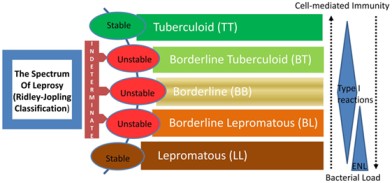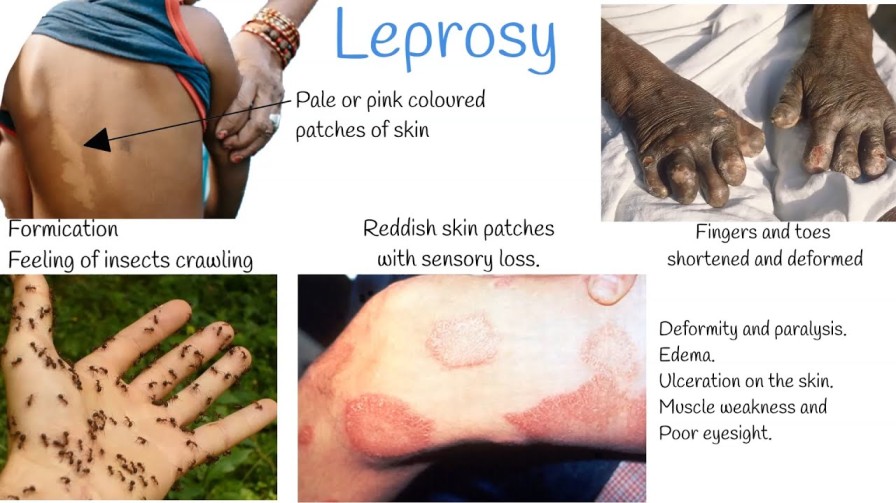Table of Contents
ToggleLeprosy
Leprosy, also known as Hansen’s disease, is a chronic infection caused by the bacteria Mycobacterium leprae and Mycobacterium lepromatosis.
It primarily affects the skin and peripheral nerves.
Cause of Leprosy
Leprosy is caused by Mycobacterium leprae and Mycobacterium lepromatosis. M. lepromatosis is a relatively newly identified mycobacterium isolated from a fatal case of diffuse lepromatous leprosy in 2008.
Transmission of Leprosy
- Nasal route via secretions
- Transplacental and breast feeding
- Genetic predisposition

Types of Leprosy:
Lepromatous leprosy (90%): This is the most common type of leprosy, accounting for about 90% of cases. It is characterized by widespread skin lesions and a weak cellular immune response. The bacteria multiply profusely in the body, leading to severe skin and nerve damage.
Tuberculoid leprosy: In this type, the immune response is stronger, and the skin lesions are few and well-defined. The affected areas may have a loss of sensation, but nerve damage is less severe compared to lepromatous leprosy.
Borderline leprosy: Borderline leprosy lies in between lepromatous and tuberculoid leprosy in terms of immune response and clinical features. It displays mixed characteristics, with moderate skin lesions and nerve involvement.
Undeterminate (Dismorphoid or Undetermined) leprosy: This type is diagnosed when the symptoms and immune response are not well-defined, making it difficult to classify precisely. It often occurs early in the disease’s progression and may eventually develop into one of the other types.
Differences between Tuberculoid, Lepromatous and Borderline leprosy
Cutaneous lesion | Tuberculoid | Lepromatous | Borderline |
Characteristic number of lesions | Few | Many | Many |
Size of lesion | Large | Small | Both – large & small |
Symmetry of lesions | Asymmetrical | Symmetrical | Symmetrical |
Surface of lesions | Rough and scaly | Smooth | Rough & scaly |
Edges | Sharp | Vague | Sharp |
Incubation Period:
The incubation period of leprosy refers to the time between when a person is exposed to the bacteria Mycobacterium leprae and the onset of symptoms. In leprosy, this period usually lasts from 2 to 5 years. However, in certain cases, especially in lepromatous leprosy, the incubation period may extend to a longer duration, lasting 8 to 12 years before signs of the disease become apparent.
Signs and Symptoms:
Leprosy presents with a variety of signs and symptoms, which may vary depending on the type and stage of the disease. Some common manifestations include:
Anaesthetic skin lesions: These are patches of skin that lose their ability to feel sensation. Individuals may not be able to detect pain, heat, or touch in these areas, making them prone to injuries.
Thickened peripheral nerves: Leprosy can affect the peripheral nerves, leading to their thickening and enlargement, often seen as lumps under the skin.
Nasal stuffiness: In some cases, leprosy can cause inflammation and swelling in the nasal passages, leading to nasal stuffiness and congestion.
Saddled nose (Saddle nose): This refers to the collapse of the nasal bridge due to the destruction of the nasal septum, which can occur in advanced cases of leprosy.
Loss of eyebrows and lashes: Leprosy can cause the loss of eyebrows and eyelashes, leading to changes in facial appearance.
Erythema nodosum: This is a condition characterized by painful, red nodules that can occur on the skin or under the skin’s surface.
Inflammatory eye changes: Leprosy may affect the eyes, leading to various eye problems, including inflammation and potential vision impairment.
Investigations
To diagnose leprosy and confirm the presence of Mycobacterium leprae, healthcare professionals may conduct several investigations, such as:
Histamine test: This test helps assess the level of nerve damage by evaluating the body’s response to histamine injection.
Lepromine test: Lepromine is a substance derived from the leprosy bacteria. The test measures the immune response to lepromine to determine the type of leprosy and the individual’s immune status.
Polymerase Chain Reaction (PCR): PCR is a molecular technique used to detect the genetic material of the bacteria in skin samples, aiding in early and accurate diagnosis.
Skin snip for Mycobacterium leprae (modified ZN): A small sample of skin is taken and stained using the modified Ziehl-Neelsen method to visualize the presence of Mycobacterium leprae under a microscope.
Treatment for Leprosy:
Tuberculoid leprosy:
- Dapsone + Rifampicin
Lepromatous leprosy:
- Dapsone + Rifampicin + Clofazimine
Borderline leprosy:
- Dapsone
Non-leprosy drugs used in the management of leprosy:
- Steroids
- Vitamin B complex
Drugs for leprosy are commonly administered in fixed drug combinations known as MDT (Multi-Drug Therapy). MDT has been a highly effective approach in treating leprosy and preventing the development of drug resistance.
Complications of leprosy include:
- Madorosis (loss of eyebrows and eyelashes)
- Nasal bridge collapse
- Ocular complications: corneal ulcer, blindness
- Leonine faces (thickened, lion-like appearance of facial skin)
- Loss of sensation to heat, pain, and light touch
- Multiple ulcerations due to nerve damage and loss of sensation
- Nerve enlargement
- Orchitis (inflammation of the testicles)
- Disuse of some parts of the body
- Contractures and shortening of phalanges, especially the 4th and 5th fingers and toes
- Elongated soft ear lobes
- Sterility in men secondary to orchitis
- Hammer toes (abnormal bending of the toes)
- Reactional states secondary to successful drug therapy (erythema nodosum leprosum).
Test Questions
Question: Leprosy primarily affects which body parts?
a) Liver and kidneys
b) Skin and peripheral nerves
c) Lungs and heart
d) Brain and spinal cord
Answer: b) Skin and peripheral nerves
Explanation: Leprosy is a chronic infection that primarily affects the skin and peripheral nerves.
Question: What is the incubation period for lepromatous leprosy?
a) 1-2 years
b) 3-5 years
c) 6-8 years
d) 8-12 years
Answer: d) 8-12 years
Explanation: Lepromatous leprosy has a longer incubation period of 8-12 years, compared to other types of leprosy.
Question: Which type of leprosy has well-defined, few skin lesions and less severe nerve damage?
a) Tuberculoid leprosy
b) Lepromatous leprosy
c) Borderline leprosy
d) Indeterminate leprosy
Answer: a) Tuberculoid leprosy
Explanation: Tuberculoid leprosy is characterized by well-defined, few skin lesions and less severe nerve damage.
Question: Which drug combination is used to treat lepromatous leprosy?
a) Dapsone
b) Dapsone + Rifampicin
c) Dapsone + Rifampicin + Clofazimine
d) Rifampicin
Answer: c) Dapsone + Rifampicin + Clofazimine
Explanation: Lepromatous leprosy is treated with a combination of Dapsone, Rifampicin, and Clofazimine.
Question: What are the complications of leprosy that may lead to blindness?
a) Loss of eyebrows and lashes
b) Nasal bridge collapse
c) Corneal ulcer
d) Erythema nodosum leprosum
Answer: c) Corneal ulcer
Explanation: Leprosy can cause corneal ulcers, which may lead to blindness if left untreated.
Question: Which investigation helps diagnose leprosy by detecting Mycobacterium leprae in skin samples?
a) Lepromine test
b) Histamine test
c) PCR
d) Skin snip for Mycobacterium leprae (modified ZN)
Answer: d) Skin snip for Mycobacterium leprae (modified ZN)
Explanation: Skin snip test with modified Ziehl-Neelsen staining is used to visualize Mycobacterium leprae under a microscope.
Question: What is the most common type of leprosy?
a) Tuberculoid leprosy
b) Lepromatous leprosy
c) Borderline leprosy
d) Indeterminate leprosy
Answer: b) Lepromatous leprosy
Explanation: Lepromatous leprosy is the most common type, accounting for about 90% of leprosy cases.
Question: Which type of leprosy has a weak cellular immune response and widespread skin lesions?
a) Tuberculoid leprosy
b) Lepromatous leprosy
c) Borderline leprosy
d) Indeterminate leprosy
Answer: b) Lepromatous leprosy
Explanation: Lepromatous leprosy is characterized by a weak cellular immune response and widespread skin lesions.
Question: What is the term used to describe the thickened, lion-like appearance of facial skin in leprosy?
a) Madorosis
b) Leonine faces
c) Erythema nodosum
d) Nasal bridge collapse
Answer: b) Leonine faces
Explanation: Leonine faces refer to the thickened, lion-like appearance of facial skin seen in some cases of leprosy.
Question: Which non-leprosy drug is commonly used in the management of leprosy?
a) Antibiotics
b) Steroids
c) Antifungals
d) Antivirals
Answer: b) Steroids
Explanation: Steroids are used in the management of leprosy to control inflammation and reduce immune reactions in some cases.

